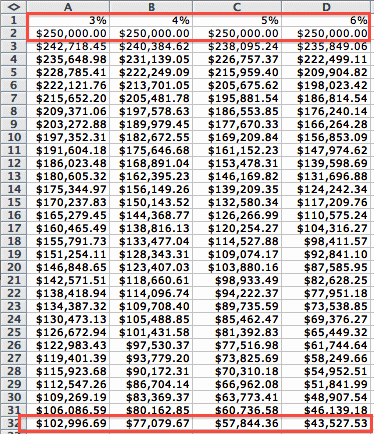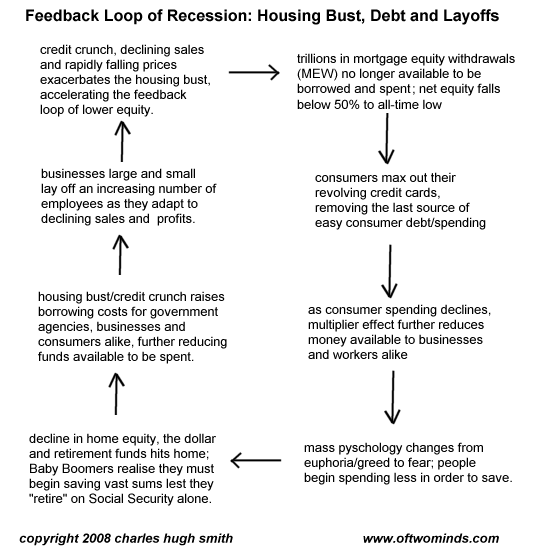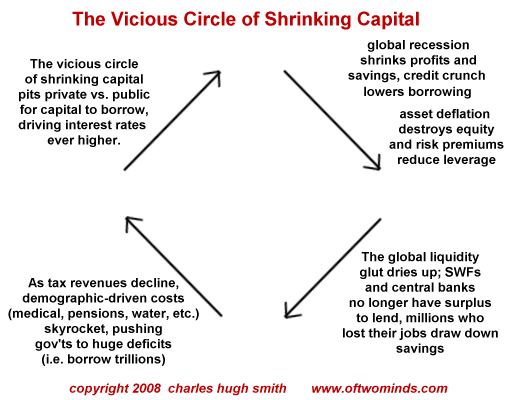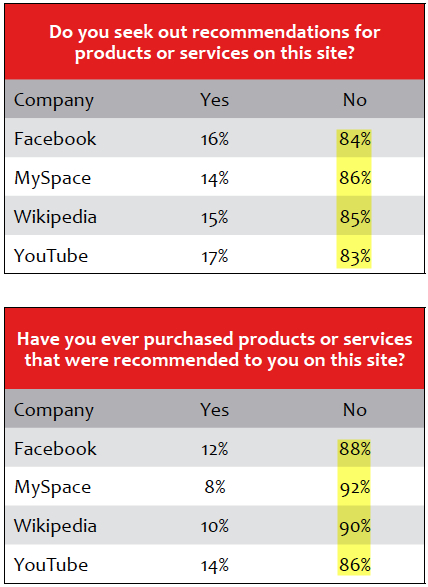What You Need to Know About Present and Future Value (FV)
What do deflation and inflation mean in terms of our mortgages and investments? We turn to the concepts of present and future value for answers.
Discussions about the impact of future deflation or inflation tend to be quasi-ideological rather than pragmatic. Today we look at the consequences in numbers we can all understand. Frequent contributor Harun I. has kindly provided an explanation of the key concepts here: present value and future value. Extending the consequences of mortgages and bond yields 30 years is a real eye-opener-- or should be.
Here is Harun's commentary:
Why is it important to understand Present Value and Future Value?
By understanding these concepts we can determine the risk/reward involved in debt, how inflation or deflation, incidence or expectation, effect risk/reward. We can also understand whether inflation or deflation who wins or loses and why. Understanding who loses and why also gives us a prelude as to how market participants can be expected to behave.
I highly recommend reading Steve Keen’s Roving Cavaliers of Credit, and watch Chris Martenson’s Crash Course. These treatises will help you to understand that
1) we have a Credit Money system
2) there is always more debt than there is money
3) because of points 1 and 2 the system is inherently leveraged and inflationary. (Leverage cuts both ways; if leveraged 40:1 a 2.5% decline wipes you out)
Any loan that is written, the lender has to factor in what will the money be worth when I the principle is returned--the inflation risk--and what is the risk that principle will not be returned--the default risk. Both concerns are based on assumptions--in essence speculations about the future, which can and do get fairly complex.
For simplicity’s sake, I will be using a risk-free rate of return of three percent to calculate Future Value (FV) and Present Value (PV). In my opinion, the risk-free rate of return is the expected rate of inflation, meaning that when your principle (factoring interest payments) is returned it will have the same purchasing power as when it was loaned.
Given in the chart is the FV of $250,000 at inflation rates of 3-6%.

So, referring to the FV chart, $250,000 at a risk-free rate of 3% per annum will be worth (or more accurately, equivalent to) $606,815 in 30 years. If this were the cost of a home and it indeed appreciated at the rate of inflation, you know what the home will cost in 30 years.
If, however, you as the lender are wrong and inflation was at 4%, the rate of depreciation of money was greater than you anticipated and therefore you would need an additional $204,033 to have the equivalent purchasing power of your original $250,000. If this happens the mortgagee wins. (emphasis added: CHS)
If at period 30 the owner wishes to sell his home, he can put it on the market at its 4% equivalent of $250K ($810,849) and pocket the difference. This concurs with one of the greatest threats to bond holders: inflation risk. And, as can be seen in columns A70, B70, and C70, the effects of being off on our speculation by just one percentage point are large indeed.
Conversely, if the risk-free rate of return was 4% but deflation of 1% actually occurred, the mortgagee would eat the difference because (assuming he didn’t default) he would only be able to put his house on the market for $606,815 versus $810,849. For the mortgage bondholder this is acceptable because he now holds a bond with an attractive rate (4% vice 3%), which if he chose to sell would fetch a premium.
Put another way: the Future Value (FV) of $250K today at 3% annually in 30 years is $606,815.62. Cell A70 is the difference of being wrong by 1 percentage point (3%-4%). B70 is the difference of 4%-5% and C70, 5%-6%.
Both lender and borrower need to understand how changes in interest rates affect PV and FV because it affects current yields and yields at maturity. This directly affects the ability to unwind the position or sell the debt or asset.
This is a very simplistic example and can get complex once risk is factored. The reason I refer to the cost of a home is because I constantly hear people comment about how they paid for their house twice once interest was factored. Well, it just happens that prices double every 30 or so years.
Bond buyers would not lend money so freely if they knew the inevitable outcome would be a loss of purchasing power. In other words, if one generally accepts that bond buyers want an income stream plus the guaranteed return of their principle, what would be the point if that fixed income stream yielded increasingly declining purchasing power to a point that the overall investment when the principle is returned is a net effective loss?
So, in a deflationary environment someone who is concerned about an income stream and safety of principle may consider lending to the Treasury at 0%. With no inflation, he doesn’t have to worry about the solvency of a bank, FDIC limits, or the loss of purchasing power--that is, if the solvency of the Treasury is not in question. If prices decline faster than income there is still a net positive outcome.
One last thing that should be obvious: achieving the risk-free rate of return, that is, achieving nothing more than the rate of inflation on your savings may yield more nominal dollars but it does not increase purchasing power. I say this because some may be over enthused about watching $250,000 go to over $600K in 30 years. No wealth has been gained; it just requires more dollars to purchase the same items. (emphasis added: CHS)
The implications of PV and FV are important. I highly recommend watching the four videos at the Khan Academy website.
Here is another chart of present value. Referring to the areas highlighted in red:

At 3% interest or inflation the PV of $250,000 projected 30 years out is $102,996.69. You can see the results of 4%, 5% and 6%. If you put $250K under your mattress for thirty years and gave up a risk-free return of 3%, or inflation progressed at 3%, your $250K lost purchasing power. Higher interest rates destroy the PV of money; this has an effect on how much I can or must borrow. At 3% $250K has a PV of $103K, at 6% $250K has a PV of only $43K.
The calculations are simple but when one spends some time thinking about these concepts, the implications are very important.
Thank you, Harun, for a very insightful commentary. I will be extrapolating some of these insights in future entries.
In essence, mortgagees (borrowers) benefit in inflation, and bond holders (lenders) suffer potentially massive declines in the value of their asset (the mortgage or bond).
In deflationary periods, the bond holders (or owners of the mortgage note) gain while the borrower loses as the value of his home deflates while the interest and principle payments on his loan remain fixed.
The concepts of PV and FV help us understand why a government bond paying an absurdly low rate of return (1%) might be an excellent investment in a deflationary environment, and why debt is a catastrophic "investment" in deflationary times.
What are the risks going forward for borrowers and lenders? Ah, if only we had a crystal ball. But lacking that, we can take our cues from the the current deflationary currents and avoid debt and high-risk speculations alike.
"What the heck, it's only the cost of a latte" $2.99 Kindle book sale: Here are quick descriptions of each novel's plot, genre and theme.
Claire's Great Adventure ($2.99)
Survival+: Structuring Prosperity for Yourself and the Nation ($9.95)
Survival+ The Primer ($5)
Weblogs & New Media: Marketing in Crisis ($5)
If you're going to buy the new $139 Kindle Reader (6" Display, U.S. Wireless, shipping August 27), please do so through my site as I earn a modest commission which costs you nothing.
If you would like to post a comment where others can read it, please go toDailyJava.net, (registering only takes a moment), select Of Two Minds-Charles Smith, and then go to The daily topic. To see other readers recent comments, go to New Posts.

Order Survival+: Structuring Prosperity for Yourself and the Nation and/or Survival+ The Primer from your local bookseller or from amazon.com or in ebook and Kindle formats.A 20% discount is available from the publisher.
Of Two Minds is now available via Kindle: Of Two Minds blog-Kindle
| Thank you, Sam R. ($50), for your awesomely generous donation to the site-- I am greatly honored by your support and readership. | Thank you, William L. ($20), for your extremely generous contribution to the site-- I am greatly honored by your support and readership. |








































